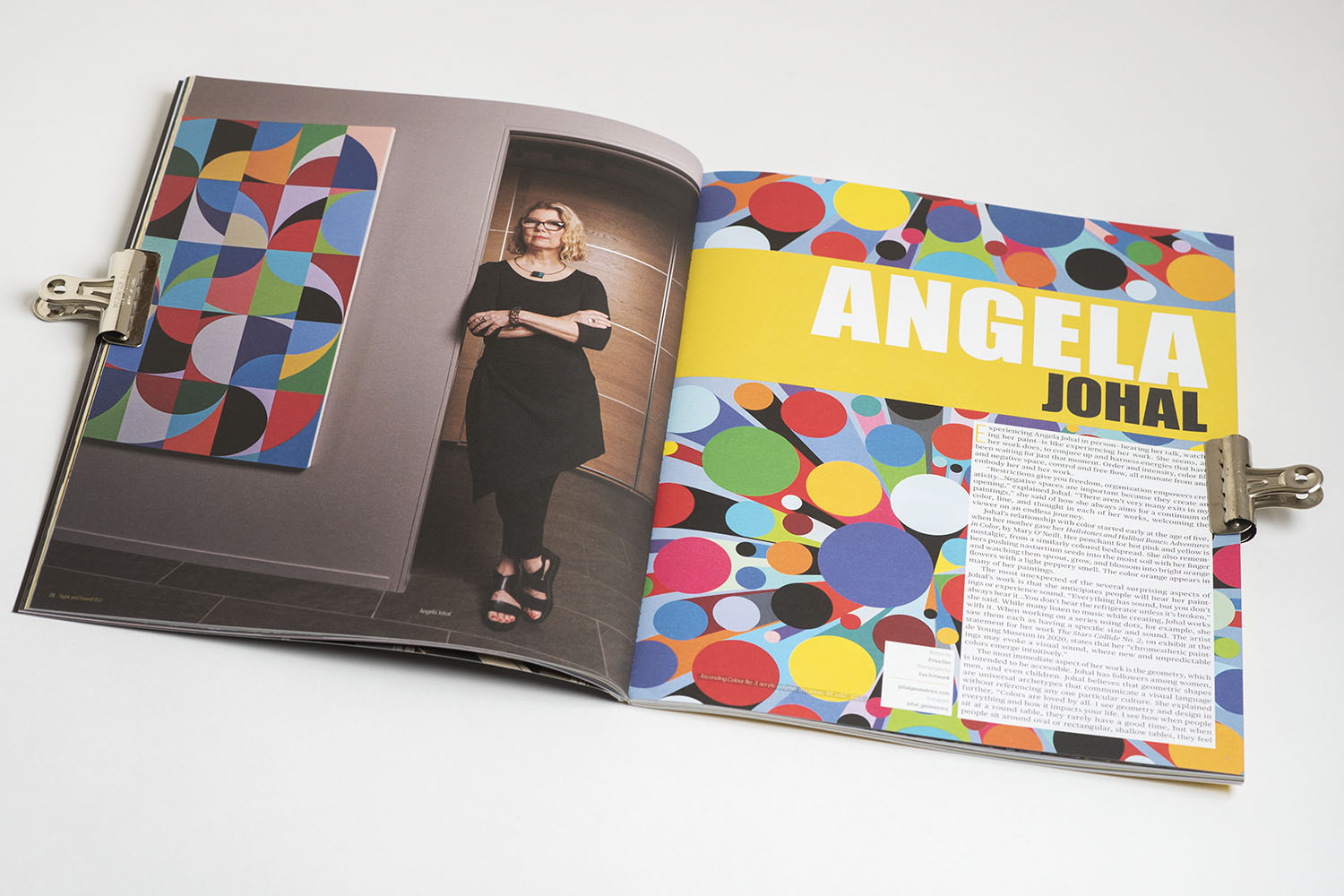
Experiencing Angela Johal in person—hearing her talk, watching her paint—is like experiencing her work. She seems, as her work does, to conjure up and harness energies that have been waiting for just that moment. Order and intensity, color fill and negative space, control and free flow, all emanate from and embody her and her work.
“Restrictions give you freedom, organization empowers creativity…Negative spaces are important because they create an opening,” explained Johal. “There aren’t very many exits in my paintings,” she said of how she always aims for a continuum of color, line, and thought in each of her works, welcoming the viewer on an endless journey.
Johal’s relationship with color started early at the age of five, when her mother gave her Hailstones and Halibut Bones: Adventures in Color, by Mary O’Neill. Her penchant for hot pink and yellow is nostalgic, from a similarly colored bedspread. She also remembers pushing nasturtium seeds into the moist soil with her finger and watching them sprout, grow, and blossom into bright orange flowers with a light peppery smell. The color orange appears in many of her paintings.
Fear is the artist’s worst enemy…I also have learned that the more mistakes you make, the better artist you become. This in turn makes you a master at problem solving.
The most unexpected of the several surprising aspects of Johal’s work is that she anticipates people will hear her paintings or experience sound. “Everything has sound, but you don’t always hear it…You don’t hear the refrigerator unless it’s broken,” she said. While many listen to music while creating, Johal works with it. When working on a series using dots, for example, she saw them each as having a specific size and sound. The artist statement for her work The Stars Collide No. 2, on exhibit at the de Young Museum in 2020, states that her “chromesthetic paintings may evoke a visual sound, where new and unpredictable colors emerge intuitively.”
The most immediate aspect of her work is the geometry, which is intended to be accessible. Johal has followers among women, men, and even children. Johal believes that geometric shapes are universal archetypes that communicate a visual language without referencing any one particular culture. She explained further, “Colors are loved by all. I see geometry and design in everything and how it impacts your life. I see how when people sit at a round table, they rarely have a good time, but when people sit around oval or rectangular, shallow tables, they feel closer, can hear, and often have a better time. How you move about spaces and the furniture and art has a profound effect on one’s well-being.”
She continued: “Color and shapes have a direct effect on your mood, and I have found that I am most satisfied when I see a whole rainbow of colors, but with the calming qualities of the black, white, and grays. I think that geometric and colorful art may have a similar effect on the brain as psychedelics.”
Johal is not kidding when she says she sees geometry everywhere—a word puzzle book was her inspiration for a time. Indeed, she always looks for lights and shadows first. And the same way a letter reveals more in a word puzzle, she believes that a single color has the power to change the entire work.
Johal’s purposeful approach has a backstory, starting from when she used to be a photorealist painter. However, those “illusions of reality” seemed false to her, while the geometric, flat color shapes felt more honest. For five years, as fascinating proof of how she inhabits the paradoxical realm of restraint and movement, she stopped painting but allowed herself to craft using only reclaimed, found materials. It was during this time that she found geometry and abstraction as her medium. Paint slowly started creeping into the collages and then she decided to go back to painting, using only flat planes of color to achieve three-dimensional effects. City Trees and Intersections were her first real geometric paintings with flat color planes, and she loved the way they gave an illusion of transparency.
When asked about her process and how she determines what her next work is going to be, Johal shared that it’s important for her to wait to see how the painting will emerge. She explained that when she creates art, she is actually spending time playing, like a child. “Fear is the artist’s worst enemy. Children are fearless when they create, where adults are always battling fear, which hinders the creative process. I also have learned that the more mistakes you make, the better artist you become. This in turn makes you a master at problem solving.”
Ultimately, Johal believes that “the artist actually becomes what they paint.”
johalgeometrics.com
Instagram: johal_geometrics

